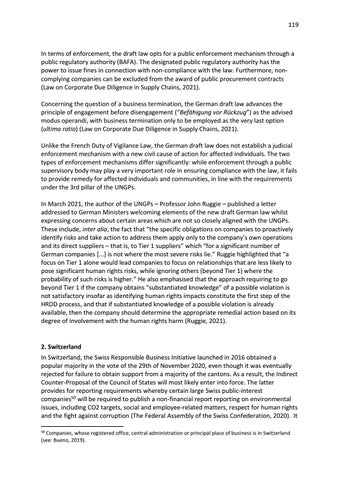119
In terms of enforcement, the draft law opts for a public enforcement mechanism through a public regulatory authority (BAFA). The designated public regulatory authority has the power to issue fines in connection with non-compliance with the law. Furthermore, noncomplying companies can be excluded from the award of public procurement contracts (Law on Corporate Due Diligence in Supply Chains, 2021). Concerning the question of a business termination, the German draft law advances the principle of engagement before disengagement (“Befähigung vor Rückzug”) as the advised modus operandi, with business termination only to be employed as the very last option (ultima ratio) (Law on Corporate Due Diligence in Supply Chains, 2021). Unlike the French Duty of Vigilance Law, the German draft law does not establish a judicial enforcement mechanism with a new civil cause of action for affected individuals. The two types of enforcement mechanisms differ significantly: while enforcement through a public supervisory body may play a very important role in ensuring compliance with the law, it fails to provide remedy for affected individuals and communities, in line with the requirements under the 3rd pillar of the UNGPs. In March 2021, the author of the UNGPs – Professor John Ruggie – published a letter addressed to German Ministers welcoming elements of the new draft German law whilst expressing concerns about certain areas which are not so closely aligned with the UNGPs. These include, inter alia, the fact that “the specific obligations on companies to proactively identify risks and take action to address them apply only to the company’s own operations and its direct suppliers – that is, to Tier 1 suppliers” which “for a significant number of German companies [...] is not where the most severe risks lie.” Ruggie highlighted that “a focus on Tier 1 alone would lead companies to focus on relationships that are less likely to pose significant human rights risks, while ignoring others (beyond Tier 1) where the probability of such risks is higher.” He also emphasised that the approach requiring to go beyond Tier 1 if the company obtains “substantiated knowledge” of a possible violation is not satisfactory insofar as identifying human rights impacts constitute the first step of the HRDD process, and that if substantiated knowledge of a possible violation is already available, then the company should determine the appropriate remedial action based on its degree of involvement with the human rights harm (Ruggie, 2021).
2. Switzerland In Switzerland, the Swiss Responsible Business Initiative launched in 2016 obtained a popular majority in the vote of the 29th of November 2020, even though it was eventually rejected for failure to obtain support from a majority of the cantons. As a result, the Indirect Counter-Proposal of the Council of States will most likely enter into force. The latter provides for reporting requirements whereby certain large Swiss public-interest companies50 will be required to publish a non-financial report reporting on environmental issues, including CO2 targets, social and employee-related matters, respect for human rights and the fight against corruption (The Federal Assembly of the Swiss Confederation, 2020). It 50
Companies, whose registered office, central administration or principal place of business is in Switzerland (see: Bueno, 2019).













